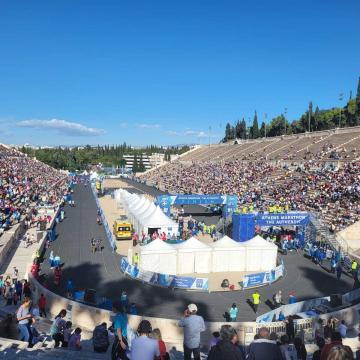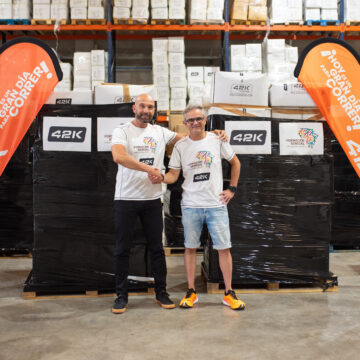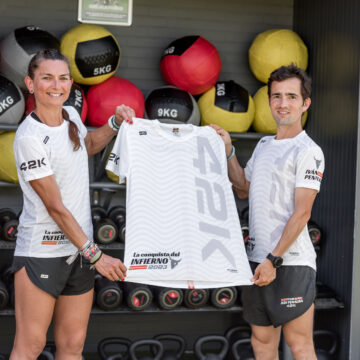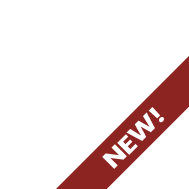Subscribe to our newsletter to find out about all the news and promotions, and automatically receive a welcome discount coupon in your email.
 We all know the prestigious sports doctor D. Luis García del Moral, director of the Institute of Sports Medicine in Valencia. Here we leave you a very interesting writing about what we can and what we really should do as popular athletes:
We all know the prestigious sports doctor D. Luis García del Moral, director of the Institute of Sports Medicine in Valencia. Here we leave you a very interesting writing about what we can and what we really should do as popular athletes:
– There are many popular athletes who are going through the IMD, with the determination to perform a stress test, to know what their current level of physical condition and health is, in order to run in a long distance test. And perhaps the hard part is not the performance of the test itself, but the moment of delivery of results, and not because some hare jumps regarding the state of health, but because an inadequate programming of intensities in training is revealed. .
From the data obtained (mainly the maximum oxygen consumption and the aerobic and anaerobic thresholds) the final evaluation will indicate the different optimal rhythms for training, which can be classified, from less to more, in: extensive aerobic rhythm, intensive aerobic pace, threshold pace and aerobic power pace, the competition pace being directly dependent on the intended competition distance. This is where many begin to realize that much of the training was misunderstood, and that the work intensities were wrong. But, that is always difficult to assimilate, given the rhythms they are used to performing, because they are the ones they perform in their sports environment, etc.
We can give an example to see it in a practical way:
1.- An athlete who believes he is ready to run the marathon in 3h30', which means that his competition pace will be approximately 5:00 min per km. He does about 50-60 km/week and the lengths are done at approximately 5:00-5:15/1000m. We already broke down the consequences and analysis of this in a previous article “Training is not competing”.
2.- There are various methods spread on the internet for calculating the intensity in the marathon, which are based on that achieved in an average. In normal situations it can be quite correct, but in many cases not.
In general, the pace in the marathon is halfway between the rate at which the aerobic threshold is recorded and that at the anaerobic threshold. On the other hand, a general rule is that we improve what we train.
If it turns out that we are training close to the anaerobic threshold (which is very common), at best, that will be what we are improving as a priority, without improving the values at the aerobic level in an equivalent way. With this, we are systematically overestimating our physical capacities for an event “halfway” between both thresholds.
3.- “But, I don't know how to run so slowly!”. Well, learn... The fact that we don't know how to do something doesn't necessarily mean that it's not what suits us.
4.- "But if I feel good at the intensities I'm going!" Couldn't we find ourselves better? Could it be that we could not improve more if we optimize our training? Moreover, probably better adjusting the intensities will mean finishing "more whole", and therefore being able to face the next training session with more energy and better disposition, even if that day it was a tough training session.
5.- "I used to do it and it was going well for me, why shouldn't it be like that now?" or, "this is what my training partners do." Training is not a standard thing. The one who starts at 16 years of age should not have the same training as the one who does it with 30, for example, nor the one who has been training for 1 year of the one who has been doing it for 20 years. And, training is a cumulative process, so what we tolerate (and may need at one point in our sports career) we may not necessarily tolerate (or need) at another.
6.- The perverse spiral: it is very common to find runners who show a very high percentage of fat compared to their total weight, despite doing 3 and even 6 training sessions per week. It does not seem very logical that if a sedentary subject should have 15% (Faulkner's Method), and taking into account that a marathon runner comes to have 8.5-9.0%, someone who is neither one nor the other, is not among socks.
And what is happening? Well, it has its explanation: as we have already pointed out before, there is a tendency, which also happens to us in almost all facets of life, to do more things in less time, which in running translates into higher rhythms. This entails a change in the way our body makes use of the different fuels it can get hold of (fundamentally fats-carbohydrates). Let's say that despite the fact that fats offer us more calories per unit of weight, however their "extraction cost" is higher, so by increasing the rate and therefore requiring more energy, the system progressively stops using them to spend to be the carbohydrates the fuel used. And that has the consequence, among others, that if we don't spend fat, then we don't lose fat. So as a premise: The important thing is not how many calories we spend, but where they come from!
Second step: since there is no way to lose weight, we started doing dietary manipulations. The most common, removing units of food.
This, which might seem good because we end up eating less, is not entirely true, nor does it fulfill the function that we intend for it. By distancing meals, 3 things will happen: 1. We will be more hungry, so we are less able to choose rationally, and what the body asks of us is tolimentos more caloric or faster absorption; 2. We have more anxiety to eat, so we will eat faster, and we will be full later, after having eaten more than if we ate "without hunger"; and 3, and more importantly: since it has been a long time without eating, blood glucose has dropped a lot (that's why we are so hungry), and since it is so low, what we eat will be absorbed faster. This produces a spike in blood glucose, and as a consequence, a spike in insulin, and this, among its actions is the so-called "lipogenesis" (formation of fatty deposits). So, we eat a plate of pasta (carbohydrates) but store it as fat.
Third step: as we see that we do not lose weight, we increase the intensity of the training, which makes the situation worse.
And with this we close the pointed circle.
It is clear that training should not be programmed by subjective sensations, but in any case, objective (based on data). And these data should not come from a single assessment of the time type obtained in this or that competition or from tests that do not assess the metabolic or ventilatory response (lactate thresholds or ventilatory thresholds). There is no evaluation method that does not take into account these two work methodologies that allow us to know precisely what the aerobic and anaerobic thresholds are, and with this, program the training individually and personally.
Luis Garcia del Moral Betzen
Sports Doctor
Jose Garay Cebrian
Physical trainer
Institute of Sports Medicine
1 comment on "Do I do what I can or do I do what I must? (By Luis García del Moral)"
Leave your comment
Other entries that they may interest you.
42K · All rights reserved














Very interesting article!